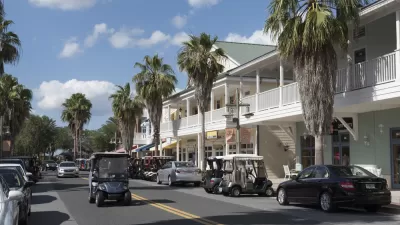Long abused by those who favor more urban settings, the suburbs of major metropolitan areas should receive more credit for their cultural capital, according to this article written for Zócalo Public Square.
Emily Goulding-Oliveira pens an appreciation for "the edgy outskirts" of large metropolitan areas. In this case, she's writing about the suburban areas of Los Angeles and São Paulo. "These flat, temperate, nearly endless expanses of homes are new, are growing, and are housing the future," writes Goulding-Oliveira.
Pushing back on the idea that suburbs are bland or even dangerous throughout the piece, Goulding-Oliveira expands on her core argument:
Globally, city outskirts are considered dangerous places and here in the U.S., with the luxury condos being built in American inner cities, poverty is increasingly appearing on the fringes. As a double citizen of these suburbs—by childhood in Temple City and by marriage in Hortolândia—I have a more sweeping and more positive view. For me, the fact that these places are vira-latas, places that flip realities, is a sign of their strength.
To the surprise of some, suburbs can also be a place that generates a great deal of the cultural trappings later co-opted in more urban areas. Goulding-Oliveira lists the recent cultural imports that can be traced to the suburbs
Most of what we call the new urban culture, from the U.S. to Brazil, is really suburban culture. The trendy food eaten in downtown L.A. or downtown São Paulo is the food developed on the outskirts: ramen burritos, fried eggs in soup, arroz e feijao, spam tacos, yucca fries. In sprawling megalopolises like Paris and our hometowns, suburbs are often where you can find the most interesting graffiti and music. Suburbs are—away from the gentrified core of these cities—where many young people and ethnic minorities are. In the suburbs, the rent isn’t too high, but the possibilities can seem endless.
FULL STORY: You Can Thank the Suburbs for the Trendy Ramen Burritos Downtown

Alabama: Trump Terminates Settlements for Black Communities Harmed By Raw Sewage
Trump deemed the landmark civil rights agreement “illegal DEI and environmental justice policy.”

Study: Maui’s Plan to Convert Vacation Rentals to Long-Term Housing Could Cause Nearly $1 Billion Economic Loss
The plan would reduce visitor accommodation by 25% resulting in 1,900 jobs lost.

Why Should We Subsidize Public Transportation?
Many public transit agencies face financial stress due to rising costs, declining fare revenue, and declining subsidies. Transit advocates must provide a strong business case for increasing public transit funding.

Paris Bike Boom Leads to Steep Drop in Air Pollution
The French city’s air quality has improved dramatically in the past 20 years, coinciding with a growth in cycling.

Why Housing Costs More to Build in California Than in Texas
Hard costs like labor and materials combined with ‘soft’ costs such as permitting make building in the San Francisco Bay Area almost three times as costly as in Texas cities.

San Diego County Sees a Rise in Urban Coyotes
San Diego County experiences a rise in urban coyotes, as sightings become prevalent throughout its urban neighbourhoods and surrounding areas.
Urban Design for Planners 1: Software Tools
This six-course series explores essential urban design concepts using open source software and equips planners with the tools they need to participate fully in the urban design process.
Planning for Universal Design
Learn the tools for implementing Universal Design in planning regulations.
Smith Gee Studio
Alamo Area Metropolitan Planning Organization
City of Santa Clarita
Institute for Housing and Urban Development Studies (IHS)
City of Grandview
Harvard GSD Executive Education
Toledo-Lucas County Plan Commissions
Salt Lake City
NYU Wagner Graduate School of Public Service





























